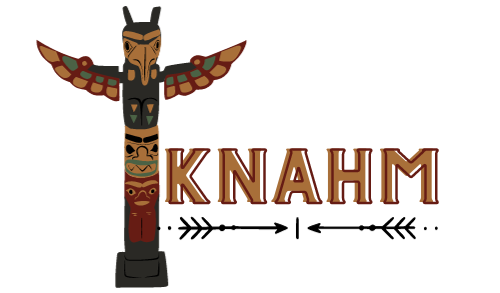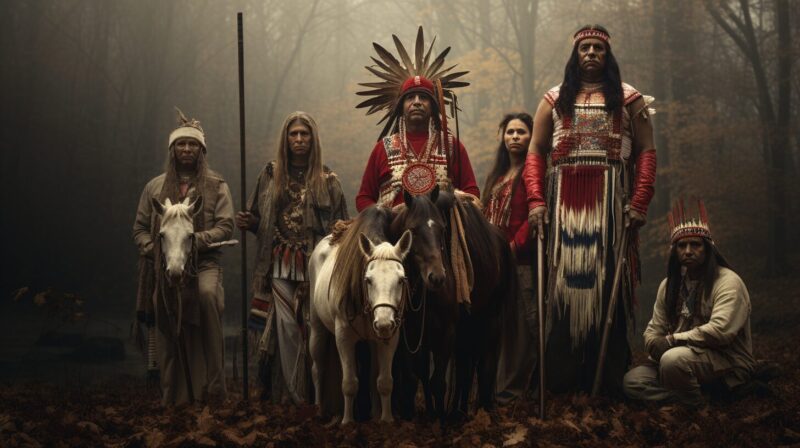I’ve always found fascination in the rich, varied, and often tragic narratives of indigenous people. One cold winter’s evening, while sifting through the annals of time, I happened upon an old map. This wasn’t just any map but a cartographer’s sketch from the early 17th century of what is now Kentucky.
It depicted numerous tribal territories – an intricate patchwork of indigenous communities that once flourished in the region. The map piqued my curiosity. Who were these communities? How did they live? What happened to them? And thus began my journey into the world of the native tribes of Kentucky.
The Early Tribes of Kentucky
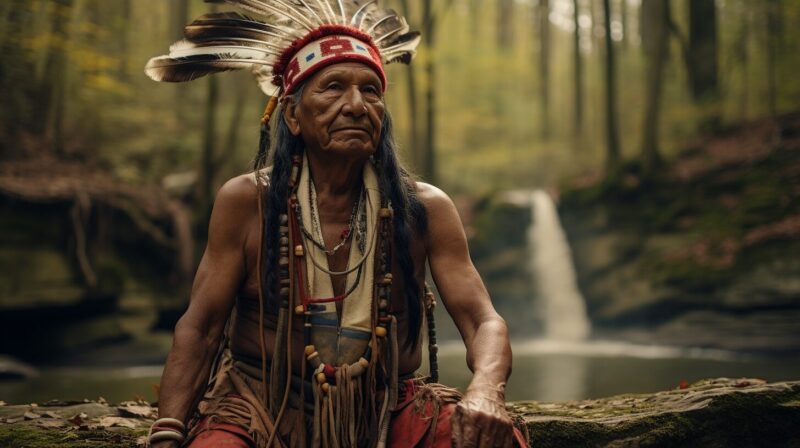
A thousand years before the arrival of Europeans, Kentucky was a vibrant tapestry of Native American life and culture.
The Archaic Period
The Archaic period (8000-1000 BCE) marked the first permanent settlements in Kentucky. Bands of hunter-gatherers discovered the rich diversity of the land and decided to call it home. Archaeological evidence from this period reveals the nomadic lifestyle they lived, hunting, fishing, and gathering plant foods. Stone tools, pottery fragments, and evidence of their first homes paint a vivid picture of this formative time.
In the Late Archaic period, tribes began to establish more permanent bases, usually near rivers. This was due to the increasing reliability of plant and animal resources. They developed advanced hunting techniques, and their tool-making skills improved as they shaped stone, bone, and shell into more diverse and specialized tools.
The Woodland Period
The Woodland period (1000 BCE-1000 CE) saw the advent of agriculture among the native tribes. Corn, beans, and squash, known as the “Three Sisters,” became staple crops. These advances led to a shift from nomadic life to more settled societies.
Horticulture transformed the tribes into semi-sedentary societies, leading to the development of communal and ceremonial sites. These changes also brought about advancements in pottery and tool-making. The Adena and Hopewell cultures, renowned for their mounds, thrived during this period.
The Mighty Cherokee
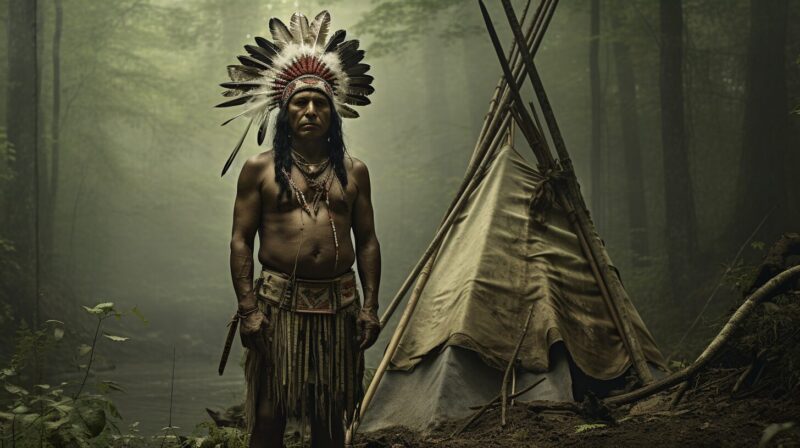
The name ‘Kentucky’ itself is derived from an Iroquoian word ‘kenta aki,’ possibly meaning ‘land of tomorrow.’ Among the numerous tribes that lived here, the Cherokee were dominant in the south and southeastern regions of Kentucky.
Life and Culture of the Cherokee
The Cherokee were an agrarian society, with corn, beans, and squash forming the core of their diet. Villages often consisted of two types of structures: winter houses that were earth-covered and semi-subterranean and summer houses constructed of pole frames and covered in bark.
Cherokee society was matrilineal, with descent and inheritance passing through the mother’s line. Their religious beliefs were deeply rooted in their everyday life, with their mythology rich in tales of nature spirits, supernatural beings, and the cycles of seasons.
Cherokee and European Encounters
The arrival of European settlers disrupted Cherokee life. Encroachment on their land led to conflict, notably in the form of the Cherokee-American wars. Despite initial resistance, the Cherokee began adopting some aspects of European culture, a process known as ‘civilization policy.’
However, the Indian Removal Act of 1830 led to the forced removal of the Cherokee, culminating in the tragic “Trail of Tears,” where thousands died en route to their new lands in Oklahoma. This marked the end of the Cherokee presence in Kentucky.
The Shawnee: Kentucky’s Warriors

Venturing north from the Cherokee lands, we encounter the Shawnee, known as fierce warriors and skilled hunters.
The Warrior Culture of the Shawnee
Unlike their Cherokee neighbors, the Shawnees were semi-nomadic, moving frequently within their territory. They were known for their martial prowess and often engaged in conflicts with neighboring tribes and, later, European settlers.
The Shawnee had a rich cultural life, with a cosmology that centered around the conflict between forces of good and evil. They believed that every living being had a spirit, and these spirits could either help or hinder humans.
The Shawnee and European Relations
The Shawnee fiercely resisted European encroachment. Leaders like Tecumseh became symbols of native resistance. However, despite valiant efforts, they couldn’t withstand the onslaught of settlers and were forced to cede their lands.
The Treaty of Greenville in 1795 officially ended their claim to Kentucky. Today, Shawnee descendants primarily live in Oklahoma, carrying on the rich traditions of their ancestors.
The Mysterious Chickasaw

The western part of Kentucky was home to the Chickasaw, a tribe shrouded in mystery due to a lack of archaeological evidence.
Chickasaw Culture and Lifestyle
Like other tribes in the region, the Chickasaw were an agrarian society. However, they were also known as skilled warriors, often engaging in warfare and slave trading.
The Chickasaw lived in fortified villages, with their homes typically being wattle-and-daub structures. They were a matrilineal society, with clan membership and leadership positions passing through the mother’s line.
Chickasaw and European Relations
The Chickasaw initially allied with the British against the French during the colonial era. However, with the increasing influx of settlers, they were eventually displaced from their lands.
In the 1830s, the U.S. government forcibly removed them to Indian Territory (present-day Oklahoma), a journey of hardship and suffering known as the “Trail of Tears.” Today, the Chickasaw Nation thrives in Oklahoma, maintaining its cultural heritage despite its turbulent history.
The Yuchi: Small but Significant

Often overlooked due to their relatively small numbers, the Yuchi played an important role in Kentucky’s Native American history.
Yuchi Culture and Society
The Yuchi, also known as the Euchee, lived in small, autonomous villages in the southeastern part of Kentucky. They were skilled farmers, supplementing their diet with hunting and fishing.
The Yuchi had a unique culture and language, distinct from their neighboring tribes. They lived in dome-shaped houses, practiced a matrilineal kinship system, and had complex religious beliefs involving numerous deities and spirits.
The Yuchi’s Interaction with Europeans
Like many other tribes, the Yuchi experienced significant disruption with the arrival of European settlers. As a result, they were forced to move several times throughout the 18th and 19th centuries.
Despite these hardships, the Yuchi managed to maintain their cultural identity and language. Today, the Yuchi are part of the federally recognized Muscogee (Creek) Nation in Oklahoma, where they continue to preserve their unique heritage.
The Monacan: Explorers from the East
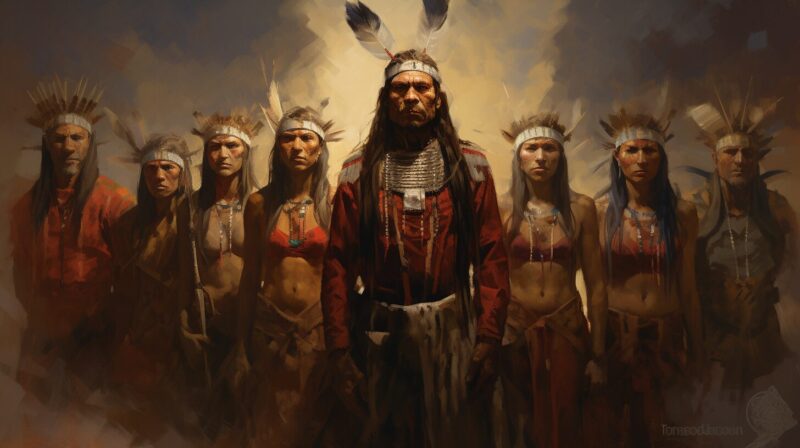
Hailing from the eastern regions, the Monacan made brief but notable forays into Kentucky, especially in areas near the Cumberland Gap.
The Monacan’s Eastern Origins
Originally from what is now Virginia, the Monacans were primarily farmers. They lived in palisaded villages, cultivating corn, beans, and squash while also relying on hunting and gathering.
Interestingly, the Monacans were one of the few Siouan-speaking tribes in the eastern US, contrasting with the Algonquian-speaking tribes that surrounded them.
Monacan Expeditions into Kentucky
Kentucky was not a primary territory for the Monacan, but archaeological evidence suggests they did explore and camp in the region. This is particularly true for the areas around the Cumberland Gap, a critical passageway through the Appalachian Mountains.
Today, the Monacan Indian Nation is federally recognized and resides primarily in Virginia, a testament to their tenacity and survival through the centuries.
The Osage: Nomads of the West

On the western edge of Kentucky, we encounter traces of the Osage, a tribe known for their nomadic lifestyle and warlike nature.
Osage Society and Traditions
The Osage were a Plains Indian tribe primarily living west of the Mississippi River. They were semi-nomadic hunters and warriors, relying heavily on the American bison.
Osage society was highly structured, divided into a complex system of clans and moieties (halves). They lived in large, communal lodges constructed from wood and earth and followed a cyclical pattern of life, moving between summer and winter villages.
Osage Encounters with Europeans
Osage interactions with European settlers were largely marked by conflict. However, over time, they began to engage in trade, particularly for horses and firearms.
The Osage were eventually pushed out of their ancestral lands, including parts of Kentucky, by European settlers and the expansion of neighboring tribes. Today, the Osage Nation is federally recognized and located in Oklahoma, continuing to honor their traditions and history.
The Miami: Northern Visitors

To the north of Kentucky, we find evidence of the Miami, a tribe primarily associated with the areas around the Great Lakes.
Miami Culture and Society
The Miami lived in villages and were known for their farming skills, cultivating corn, beans, and squash. They also hunted and fished, reflecting their adaptation to the diverse ecosystems of the Great Lakes region.
The Miami had a rich spiritual tradition, believing in a variety of spirits and supernatural beings. They also had a strong tradition of oratory, with speeches playing a crucial role in political and ceremonial life.
Miami’s Encounters with Europeans
With the arrival of Europeans, the Miami played a crucial role in the fur trade. However, the pressure of settlers and land loss eventually led to their displacement.
Despite these challenges, the Miami people survived and maintained their cultural identity. Today, the Miami Tribe of Oklahoma is federally recognized, and efforts to revive the Miami language and heritage are ongoing.
Kentucky Today: The Legacy of Native Tribes

Though forcibly removed from their ancestral lands, the legacy of these tribes can still be felt in Kentucky today.
The Archaeological Imprint
Numerous archaeological sites throughout the state bear witness to the lives of the native tribes. From the shell mounds of Green River to the rock shelters of Red River Gorge, each site tells a unique story.
- Green River Shell Mounds: These shell middens provide valuable insight into the early tribes’ diet and lifestyle.
- Adena Mounds: Found throughout Kentucky, these mounds offer glimpses into the ceremonial life of the Adena culture.
- Red River Gorge Rock Shelters: The shelters contain evidence of native tribes’ use over thousands of years.
Cultural Influence and Recognition
Today, the influence of these tribes is visible in the names of Kentucky’s rivers, towns, and counties. Furthermore, events such as Native American Heritage Month help bring awareness and recognition to the tribes’ history and culture.
Sadly, no federally recognized tribes exist in Kentucky today. However, organizations like the Kentucky Native American Heritage Commission strive to preserve and promote the legacy of the state’s indigenous peoples.
The history of Kentucky’s native tribes is a testament to their resilience and survival. It’s a narrative that deserves to be remembered, honored, and shared – a vital piece of Kentucky’s rich historical tapestry.
Final Words
Thank you for accompanying me on this historic journey. As we learn more about these tribes, we not only enrich our understanding of the past but also foster a deeper respect for the native cultures that continue to thrive today, despite all odds.
